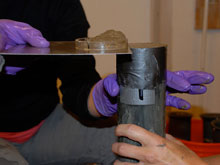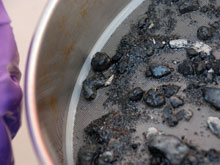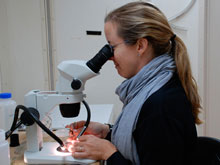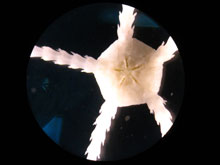
This push core shows discrete layers in a typical sediment sample. Click image for larger view and image credit.
A Hidden World Beneath the Corals
August 26, 2009
Amanda Demopoulos
Benthic Ecologist
U.S. Geological Survey
Coral reefs, whether in shallow or deep waters, are rich with life. Not only are coral reefs homes to the fish and invertebrates that we can see, but many small animals also live within the complex matrix of living reefs. These hidden residents use the coral framework for habitat. Practically invisible to the naked eye, these small animals are abundant. In fact, they represent a major component of the coral reef diversity.
I am interested in identifying these small coral associates and examining their trophic interactions. I want to figure out what species live there. Which are the most abundant species and which are the rare ones? What are the interactions among these species, including who is eating what? Patterns in species composition, abundance, and diversity can all be a function of the environment in which they live, including food supply and quality.

A top 1-centimeter sediment layer is sliced from rest of core. Click image for larger view and image credit.
Meiofauna in Seafloor Mud
As a benthic ecologist, I study animals associated with the seafloor, whether coral reefs, mud, or mangroves. These animals come in various shapes and sizes. The specific groups I am interested in include the meiofauna (less than 0.3 millimeter) and macrofauna (greater than 0.3 mm). We use fine mesh screens to sift them from the sediment. Due to their small size, we must use very careful techniques to collect and preserve these animals. Also, we must use of a microscope for initial identification.
Animals residing within the seafloor can provide a variety of ecosystem functions and services, including providing food for other fauna or altering the sediment environment. For example, animals can alter sediment chemistry just by creating burrows and moving through the mud, much like earthworms do in the garden. This activity may make the benthic environment more or less hospitable for other species. These ecosystem functions may influence what lives there as well as species interactions. So, small animals can be very telling of the environment.
Collecting Samples from the Seafloor
I use a variety of gear to collect these animals in the deep sea, including push cores and vacuum suction samplers operated by the remotely operated vehicle (ROV) Jason. (Watch today’s video clip to see Jason taking a push core sample.) A push core is simply a 50-centimeter (20-inch) clear plastic tube with a T-handle on top. The ROV grasps the T-handle and pushes the tube through the sediment. Then the ROV pulls up on the T-handle and removes the tube from the sediment with a sample inside and returns the tube to the quiver on Jason's basket. The sample is good if it makes a plug in the bottom that seals the sediment into the tube. When the ROV returns to the ship, I remove the tubes and place them into a cold (2°C, or 35ºF) room until I am ready to process them. While still on the ship, we extrude each core on a plunger that pushes the mud to the top, we slice sections of the sediment down to 10 cm (4 in), and preserve each section for further processing.
Back at the lab, the slices of mud are sieved through a screen to remove the mud and isolate the animals. I work with others in my lab to sort and identify the animals under a microscope. Typically, we find most of the animals within the upper 3 cm (1 in) of sediment. Usually, this is because their food is more plentiful at the sediment surface and/or the sediment environment is often more hospitable in these surface layers. In the end, we will compare the different community studies to characterize the abundance and diversity of these coral associates.
One question that I am often asked is why I am interested in these tiny animals. I find their complex shapes and patterns fascinating. Some have plates, like armor protecting their soft bodies. Others are very colorful, and still others have various hairs and patterns that are unique. My favorite part is to sort the samples live so that I can watch the animals in action. In our collections thus far, we have found many animals that typically would be associated with reefs, but in miniature sizes. For example, in a recent deep coral cruise off Cape Canaveral, we found a small sea urchin in the sediments at the base of live coral. Other miniaturized animals include sea stars, small polychaete worms, and crabs. Often the most abundant animals include tiny worms and crustaceans.
It will be exciting to see what we discover from this cruise in the Gulf of Mexico once we return to the lab and sort through these collections. Ultimately, the potential for discovering new species and enhancing our understanding of species interactions are high, given what little we know about these small animals living beneath these reefs.






























